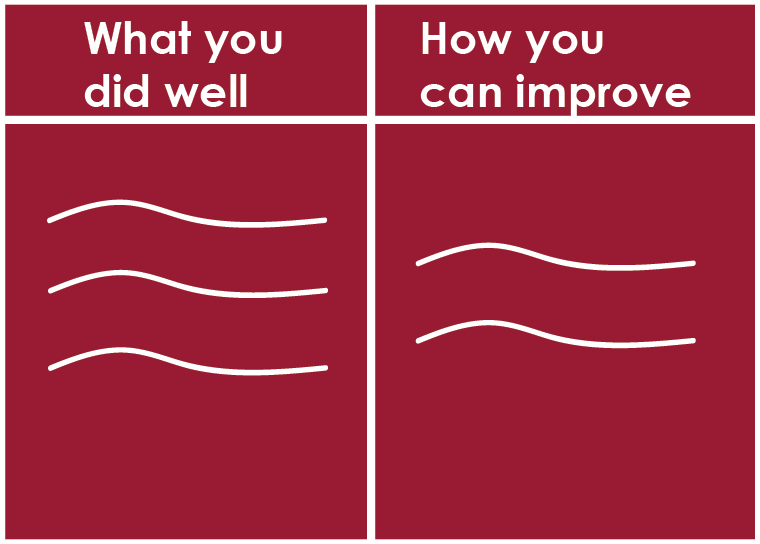5.3 Giving and Receiving Feedback
Good communication and learning in an online environment requires giving and receiving feedback. You might give feedback to classmates in a group project, or receive feedback from your classmates and instructors. What strategies can help you use feedback most effectively?
Feedback Criteria
 Effective feedback must include:
Effective feedback must include:
- What is being done correctly and well.
- How it can be improved.
- What the next steps might be.
Image credit: Rawia Inaim
Receiving Feedback
If another person offers you feedback, it may sound like criticism. It may be that they intend to be positive but they may not know how to say something positively. It may also be that their self-esteem is low and they are being defensive or aggressive towards you. Most importantly, you may become defensive or aggressive if you see their feedback as critical or negative, no matter what was meant.
Attempt to suspend your reaction until you understand the information that is being given. Paraphrase what you hear. If it seems unclear, ask for clarification. Having it presented in other words or from another point of view may increase your understanding about what is being said.
Explore and discover the reasons for the comments.
- Is a change by you indicated?
- Is it an evaluation of the past or an indication for the future?
Think about and cope with your possible defensive reaction.
- Do you see wants as demands?
- Do you feel guilty or obligated?
- Are you hearing more than is being said?
Ideally, listen to his/her comments and find the positive side of them. Then, explain your position or point of view without feeling that you must justify yourself. Determine the importance of the message to you. You may choose not to change.
Any discussion will profit from more information. You can wall yourself away from information and change by being defensive. You may open new lines of communication by being open.
Giving Positive Feedback
It is easy to criticize and to think that we are helping a person deal with a situation. To give the right commentary, at the right time, to the right person, with the right reasons, in the right way, and to the right degree is very difficult.
You first need agreement to interact. If the other person is not ready to hear your comments, you set up a negative interaction that will cause them to block you and your opinions out. If you do not have permission to comment, you may be seen as aggressive and the other person may respond by being aggressive or defensive towards you.
Ask if the other person wants your feedback. If they say no, then you will have to discuss or problem-solve that before you say anything more, or you will say nothing at all.
Search out all the facts you can prior to giving your feedback. Ask the people involved about what they feel is happening and how they see the situation. This may solve or help to solve the problem.
Time the discussion so that you are all reasonably unstressed. Leave time so there is another chance to talk before a parting of ways. This will help to avoid or clear misunderstanding or confusion.
Be Positive. Try to begin and end your feedback with comments about what is working, correct, or right about the situation. No matter how bad you perceive things to be, there will be good points to comment on.
Avoid using absolutes or negative words, words like always or never or don’t. Each situation tends to be many shades of grey rather than black and white. Actions taken are seen by each person in the light of his/her own experiences and perceptions. Use alternative positive words and phrases. Avoid comparing the person involved to other people in other situations. The where, when, what, and who of each situation are different. Comparisons tend to produce resentment and frustration.
Be Specific in your description of the problem. Avoid vague or misleading statements. If attitude seems to be a problem, show specific instances and then take one point at a time so as not to overload or overwhelm the other person. Make sure that it is something that can be changed.
When you tell someone that you feel they could improve or change, then also make suggestions on how you think they might go about making those changes, and what behaviour would be observed if the changes were made. Be prepared for no change.
Feedback can be Positive if it:
- is offered at the right time and place,
- is offered with comments on good points as well as possible changes,
- is connected to facts and not rumours,
- is directed to behaviour that can be changed,
- is specific and one point at a time, and
- gives information and possible solutions to change the situation.
You will not use all of these items in all circumstances, but all of them can be used in some situations.
Adapted from: KPU Learning Centres, & Macpherson, A. (2017). Level One Peer Tutoring Fundamentals Workbook. Kwantlen Polytechnic University. Retrieved from https://kora.kpu.ca/islandora/object/kora:98[/footnote]
Click here to access the "Give and Receive Feedback" activity in an alternative format.

